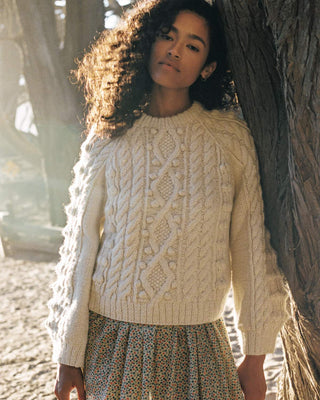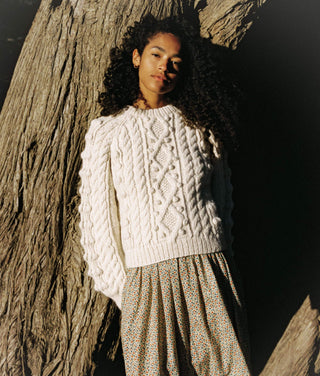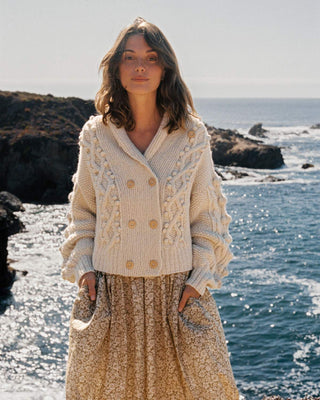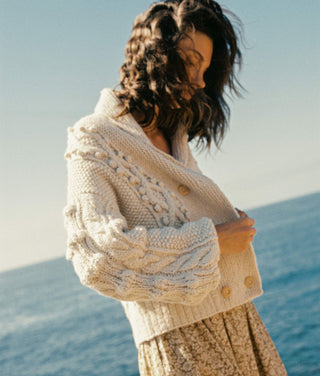1 Year
10 Days
And
5 Minutes
To Make.
The World’s First Regenerative Alpaca Collection

Join the Regenerative Evolution:
Our Farm-to-Closet initiative is an invitation to step into the circle of regeneration — to wear your values and invest in healing, while dressing yourself in beauty too.
In partnership with the Andean Pastoral Livelihoods Initiative and Revolution Knits.

Alpacas are the newest members of the Regenerative Evolution and the stars of our latest Farm-to-Closet Collection. Each sweater in this collection is made from the softest alpaca wool, then hand spun and knit by Peruvian artisans who are all paid a living wage.
The Timeline of a Regenerative Alpaca Sweater:
Total:
1 Year
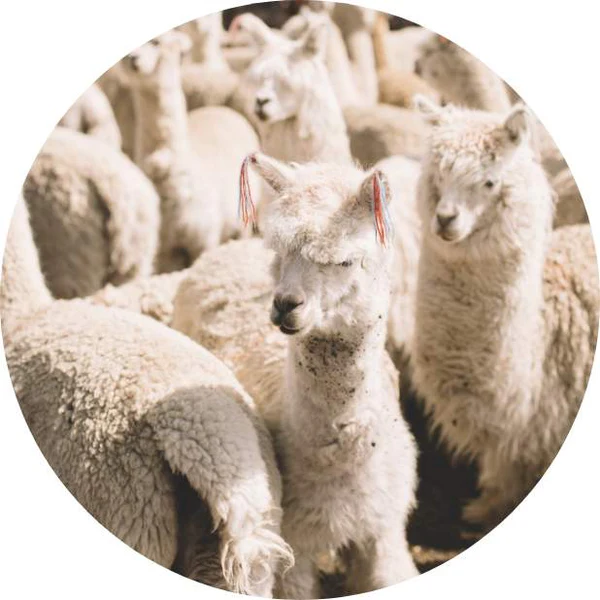
From November to November, Alpacas roam the high grasslands of Peru, grazing the flora and growing their hair.
5 Minutes

With great animal husbandry skills, the alpaqueros shear their animals - a fundamental step to maintaining animal health.
3 Days

The freshly shorn fiber is washed to remove dirt and oil, then dried in the Sun for a few days.
1 Day
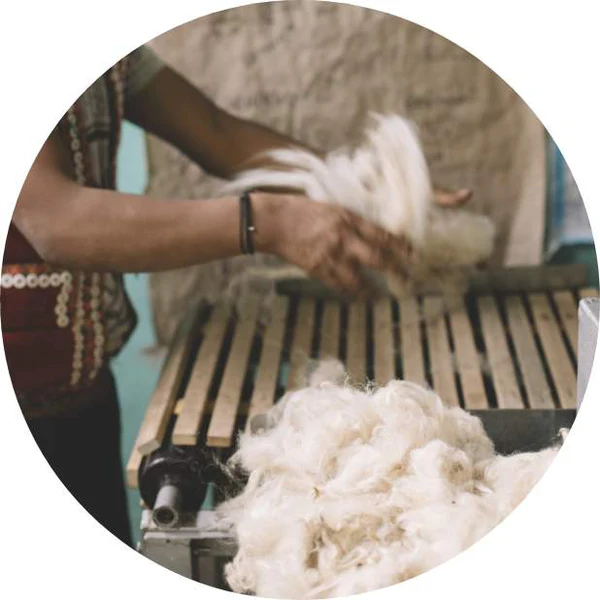
The fiber is combed, brushed and combined to create a thick, yarn-like material called “tops”
2 Days
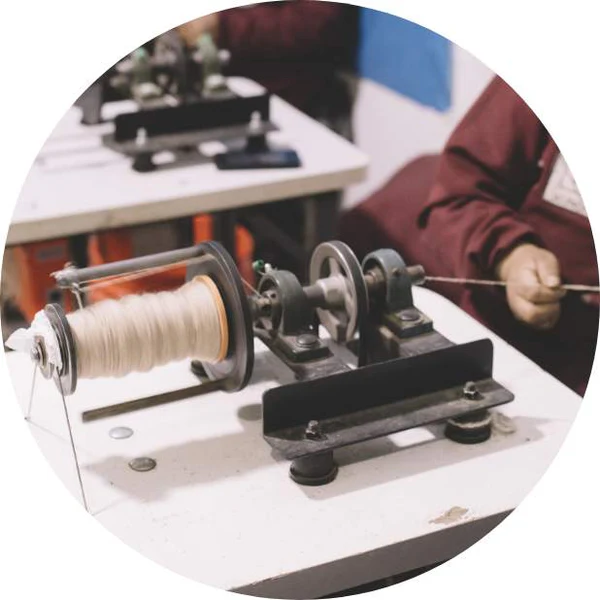
Skilled artisans twist the thick tops fiber into tight, fine yarn, using foot-powered spinning wheels.
4 Days

Hand-knitters, who are part of a cooperative in Lima, Peru, take the yarn home with them and knit it into sweaters.
The Farm-To-Closet Collection
Shop The Collection
Db 12,718,000
- Unit price
- /per
Db 13,922,000
- Unit price
- /per
Db 4,818,000
- Unit price
- /per

How Are They Regenerative?
Adaptive Management:
- Graze
- Rotate
- Regenerate
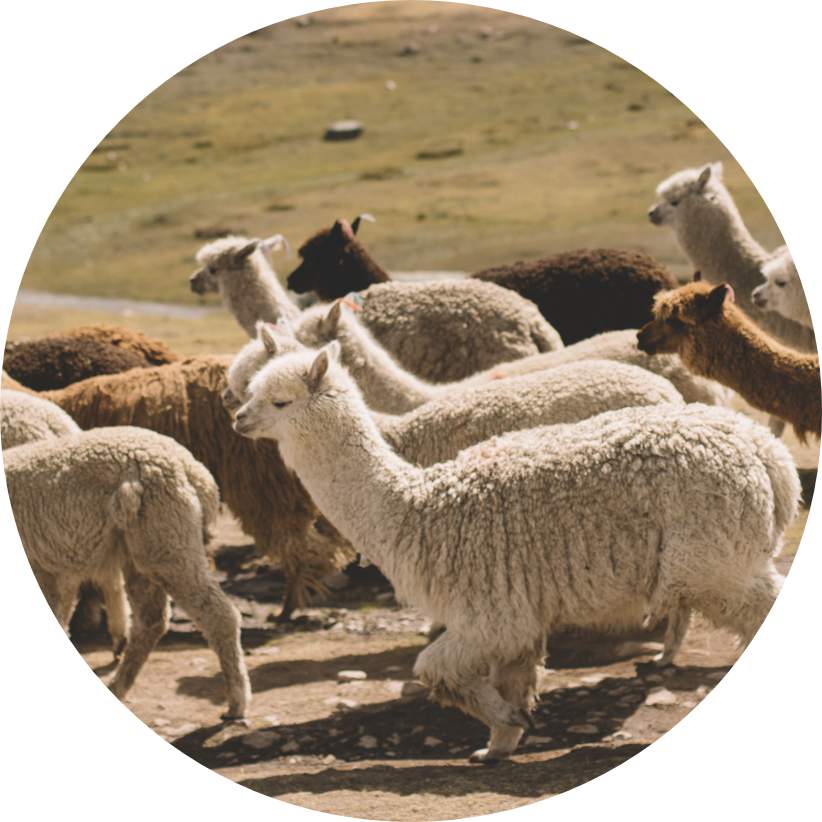


Alpacas roam the high grasslands of Peru, eat the native grasses and drink from the freshwater streams and lakes.
To ensure alpacas don’t overgraze or over fertilize the soil and waterways, the alpaqueros move them to new pastures every couple of weeks, letting the old pasture regrow and recover.
Alpacas and grasslands have a reciprocal relationship: the grass feeds the alpacas and the alpacas fertilize to increase soil health, prevent overgrowth, and increase biodiversity.

- Graze
Alpacas roam the high grasslands of Peru, eat the native grasses and drink from the freshwater streams and lakes.

- Rotate
To ensure alpacas don’t overgraze or over fertilize the soil and waterways, the alpaqueros move them to new pastures every couple of weeks, letting the old pasture regrow and recover.

- Regenerate
Alpacas and grasslands have a reciprocal relationship: the grass feeds the alpacas and the alpacas fertilize to increase soil health, prevent overgrowth, and increase biodiversity.
Peatland Restoration:
- Identify
- Restore
- Regenerate


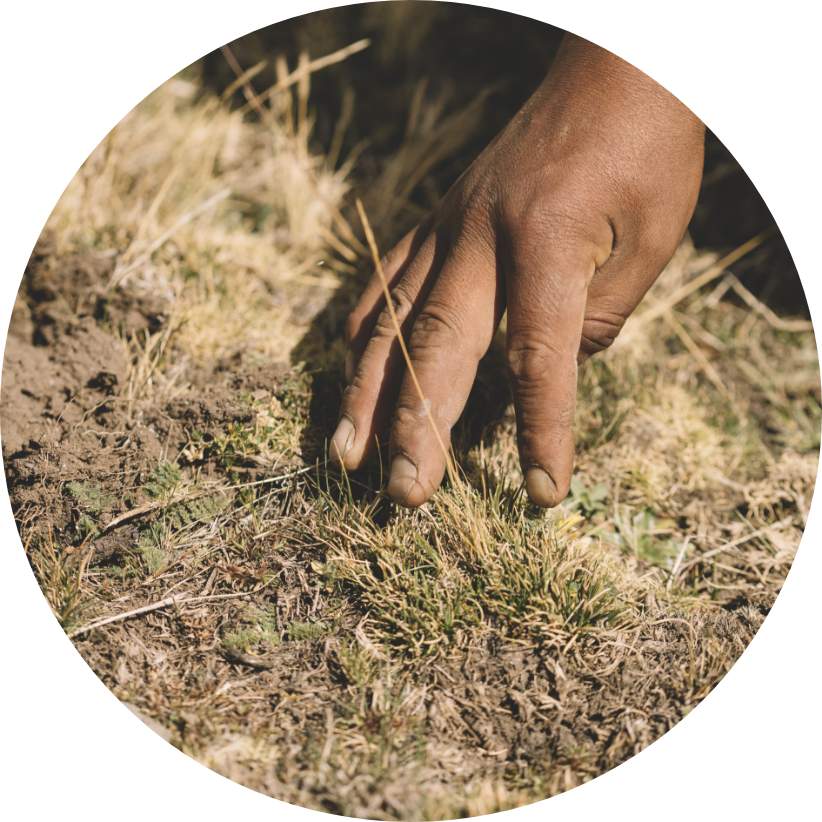
The alpaceros we partner with steward parts of the high-grasslands that are home to peatland, a type of wetland that stores a vast amount of carbon.
Prior generations who stewarded the land diverted the peatland water, but today, the alpaceros are rebuilding the peatlands and letting nature take its course.
Peatland restoration leads to cleaner waterways, ecosystem resilience, increased biodiversity, carbon sequestration and clean water security to Peruvian cities and towns.

- Identify
The alpaceros we partner with steward parts of the high-grasslands that are home to peatland, a type of wetland that stores a vast amount of carbon.

- Restore
Prior generations who stewarded the land diverted the peatland water, but today, the alpaceros are rebuilding the peatlands and letting nature take its course.

- Regenerate
Peatland restoration leads to cleaner waterways, ecosystem resilience, increased biodiversity, carbon sequestration and clean water security to Peruvian cities and towns.
Peatland soil holds the most carbon in the world — while these special wetlands are only 3% of the Earth’s land mass, they store around 33% of the world’s overall carbon.
Reciprocity between the land, the people who tend it and ourselves.

When this initiative began, we were determined to pay not only the alpaceros a living wage, but everyone within the chain of production, including the skilled knitters who are part of a fair-trade group.
Compared against market price:
- The alpaceros have now made 25% more for their fleece
- The artisans who classify the fiber made 100% more
- The spinners have made 50% more
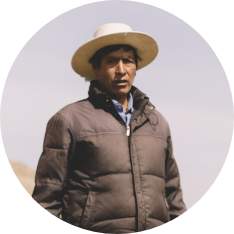
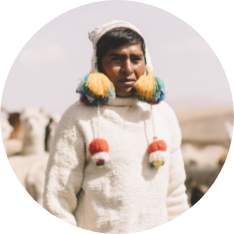
Meet Mario and Porfirio — each sweater is made with yarn from their alpaca farm in Tinke, Peru. Mario and Porfirio work with the land and the alpacas, nurturing mutually beneficial relationships in which everyone benefits — including the Earth. Alpacas are a part of their Quechuan identity.
The Farm-To-Closet Collection
Shop Farm-to-Closet.
Heal Mother Earth.
The Dawn Dress Daisy Field Blue
Available in 20 colors
Db 4,770,000
- Unit price
- /per
Db 6,215,000
- Unit price
- /per
Db 5,974,000
- Unit price
- /per
The Madeline Dress Lantana Blooms Black
Available in 2 colors
Db 8,864,000
- Unit price
- /per
The Emma Dress Noir Poppies
Available in 4 colors
Db 8,382,000
- Unit price
- /per
The Kelly Dress Noir Phlox
Available in 7 colors
Db 7,178,000
- Unit price
- /per
The Wren Tee Ivory
Available in 2 colors
Db 2,361,000
- Unit price
- /per
The Lia Dress Bleu Tulips
Available in 2 colors
Db 9,105,000
- Unit price
- /per
The Lia Dress Noir Phlox
Available in 2 colors
Db 9,105,000
- Unit price
- /per
The Dawn Dress Petites Carnelian Aster Garden
Available in 14 colors
Db 4,770,000
- Unit price
- /per
The Lia Dress Petites Noir Phlox
Available in 2 colors
Db 9,105,000
- Unit price
- /per
The Lia Dress Petites Bleu Tulips
Available in 2 colors
Db 9,105,000
- Unit price
- /per
The Eliana Dress Petites Verte Tulips
Available in 3 colors
Db 9,587,000
- Unit price
- /per
Db 9,105,000
- Unit price
- /per
The Dawn Dress Blooming Crocus
Available in 20 colors
Db 4,770,000
- Unit price
- /per
The Dawn Dress Carnelian Aster Garden
Available in 20 colors
Db 4,770,000
- Unit price
- /per
The Dawn Dress Solstice Patchwork
Available in 20 colors
Db 4,770,000
- Unit price
- /per
The Emma Dress Petites Noir Poppies
Available in 2 colors
Db 8,382,000
- Unit price
- /per
The Dawn Dress Noir Phlox
Available in 20 colors
Db 4,770,000
- Unit price
- /per
The Dawn Dress Verte Tulips
Available in 20 colors
Db 4,770,000
- Unit price
- /per
The Dawn Dress Petites Noir Phlox
Available in 14 colors
Db 4,770,000
- Unit price
- /per
The Dawn Dress Petites Verte Tulips
Available in 14 colors
Db 4,770,000
- Unit price
- /per
Db 7,901,000
- Unit price
- /per
Db 8,864,000
- Unit price
- /per
The Kelly Dress Petites Noir Phlox
Available in 2 colors
Db 7,178,000
- Unit price
- /per
Db 8,864,000
- Unit price
- /per
The Adele Dress Petites Creme Strawberry
Available in 3 colors
Db 9,587,000
- Unit price
- /per
The Wren Tee Celeste
Available in 2 colors
Db 2,361,000
- Unit price
- /per
Db 9,587,000
- Unit price
- /per
The Adele Dress Petites Night Garden
Available in 3 colors
Db 9,587,000
- Unit price
- /per
The Evelyn Dress Petites Celeste
Available in 2 colors
Db 6,696,000
- Unit price
- /per
The Adele Dress Night Garden
Available in 4 colors
Db 9,587,000
- Unit price
- /per
The Adele Dress Extended Night Garden
Available in 8 colors
Db 9,587,000
- Unit price
- /per
The Evelyn Dress Celeste
Available in 2 colors
Db 6,696,000
- Unit price
- /per
Maria Quilted Duffel Oak Leaf
Available in 2 colors
Db 5,733,000
- Unit price
- /per
Maria Quilted Duffel Noir Daisy
Available in 2 colors
Db 5,733,000
- Unit price
- /per
Db 9,105,000
- Unit price
- /per
Db 7,178,000
- Unit price
- /per
The Marie Dress Autumn Garden Bisque
Available in 2 colors
Db 7,901,000
- Unit price
- /per
The Dawn Dress Night Rose Lattice
Available in 20 colors
Db 4,770,000
- Unit price
- /per
The Dawn Dress Extended Night Rose Lattice
Available in 18 colors
Db 4,770,000
- Unit price
- /per
The Dawn Dress Petites Midnight Floral
Available in 14 colors
Db 4,770,000
- Unit price
- /per
The Dawn Dress Extended Midnight Floral
Available in 18 colors
Db 4,770,000
- Unit price
- /per
The Skylar Top Green Petunia Dot
Available in 4 colors
Db 4,288,000
- Unit price
- /per
Db 7,178,000
- Unit price
- /per
The Dawn Dress Ocean Seashell
Available in 20 colors
Db 5,492,000
- Unit price
- /per
Db 1,638,000
- Unit price
- /per
The Dawn Dress Noir Daisy
Available in 20 colors
Db 5,492,000
- Unit price
- /per
The Dawn Dress Petites Noir Daisy
Available in 14 colors
Db 5,492,000
- Unit price
- /per
The Dawn Dress Extended Noir Daisy
Available in 18 colors
Db 5,492,000
- Unit price
- /per
When you shop Farm-to-Closet, you are actively joining the Regenerative Evolution. Each purchase helps replenish even more soil, sequester even more carbon. Plus, you’re wearing a garment with reciprocity stitched and now knitted into every seam. If you pay attention, you can feel it.
The Truth Is:
We Can Stop Global Warming.

The Regenerative Evolution: Learn More
Learn About How We Grow Our Cotton:

Regeneration is about mutually beneficial relationships — reciprocity between the land, the people who tend it and ourselves. Our Farm-to-Closet initiative is an invitation to step into the circle of regeneration — to wear your values and invest in healing, while dressing yourself in beauty too.
Frequently Asked Questions
Your questions answered:
-
How does regenerative farming heal Mother Earth?
Nature is self-healing — regenerative farming fosters the plants and soil’s innate ability to build the health and resilience of their ecosystem. By using selective grazing and holistic, indigenous farming practices, farmers can revitalize soil and draw down carbon. Regenerative farming not only heals the land’s immediate ecosystem but helps heal Mother Earth from climate change.
-
How did Farm-to-Closet foster mutually beneficial relationships?
As we’ve grown, we’ve come to realize that relationships are at the core of everything we do — relationships to people, to Mother Earth, and to ourselves. The alpaceros and alpacas roam the grasslands in a way that nourishes the soil for future plants and provides farmers, spinners, weavers and dyers with a living wage, opportunities for growth and education, and a method for preserving ancient practices and traditions. This in turn gave us healthy, regenerative alpaca fleece for this collection. What’s good for Mother Earth is good for us, too.
-
Why is the regenerative alpaca collection so limited?
This is our first year working with this community to create sweaters. We started small with the plan to build capacities, so that we can source the all the alpaca fiber for future collections from this project. We will achieve this by investing a part of the profit from every Christy Dawn purchase back into the soil with the awareness that regeneration is a continuous practice. We are excited to improve and foster even more healing in the future!

